Ernestine Eckstein
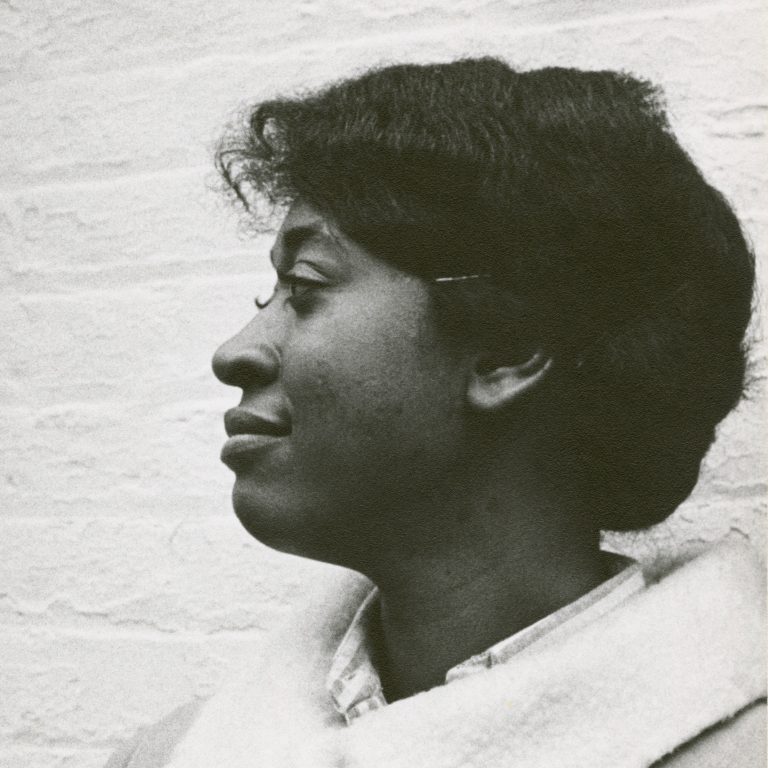 Ernestine Eckstein, 1966. Credit: Photo by Kay Tobin Lahusen, courtesy of the Manuscripts and Archives Division, The New York Public Library.
Ernestine Eckstein, 1966. Credit: Photo by Kay Tobin Lahusen, courtesy of the Manuscripts and Archives Division, The New York Public Library.Episode Notes
Ernestine Eckstein is an iconic figure from the 1960s homophile movement—from photos showing her as the only African American woman at the earliest protests to her trailblazing cover story in The Ladder. Now we can put a voice to those images with a never-before-heard 1965 interview.
Episode first published January 24, 2019.
———
From Eric Marcus: Back in the late 1980s, one of the people I was keenly interested in including in my oral history book was someone who jumped out at me from a vintage photograph. She was a lone African American woman in a 1965 gay picket line in front of the White House.
I was able to put a name to the face—or, rather, a pseudonym. As was common at the time, Ernestine Eckstein didn’t use her real name in the movement. Ernestine appeared in another iconic photo—on the June 1966 cover of The Ladder, the Daughters of Bilitis magazine. She was the first African American to do so, despite the potential risk of being found out and fired from her civil service job.
So I searched for Ernestine, and searched, and searched, but found only dead ends. Trying to find someone using just a pseudonym, and long before the Internet, was an uphill struggle. Eventually I gave up.
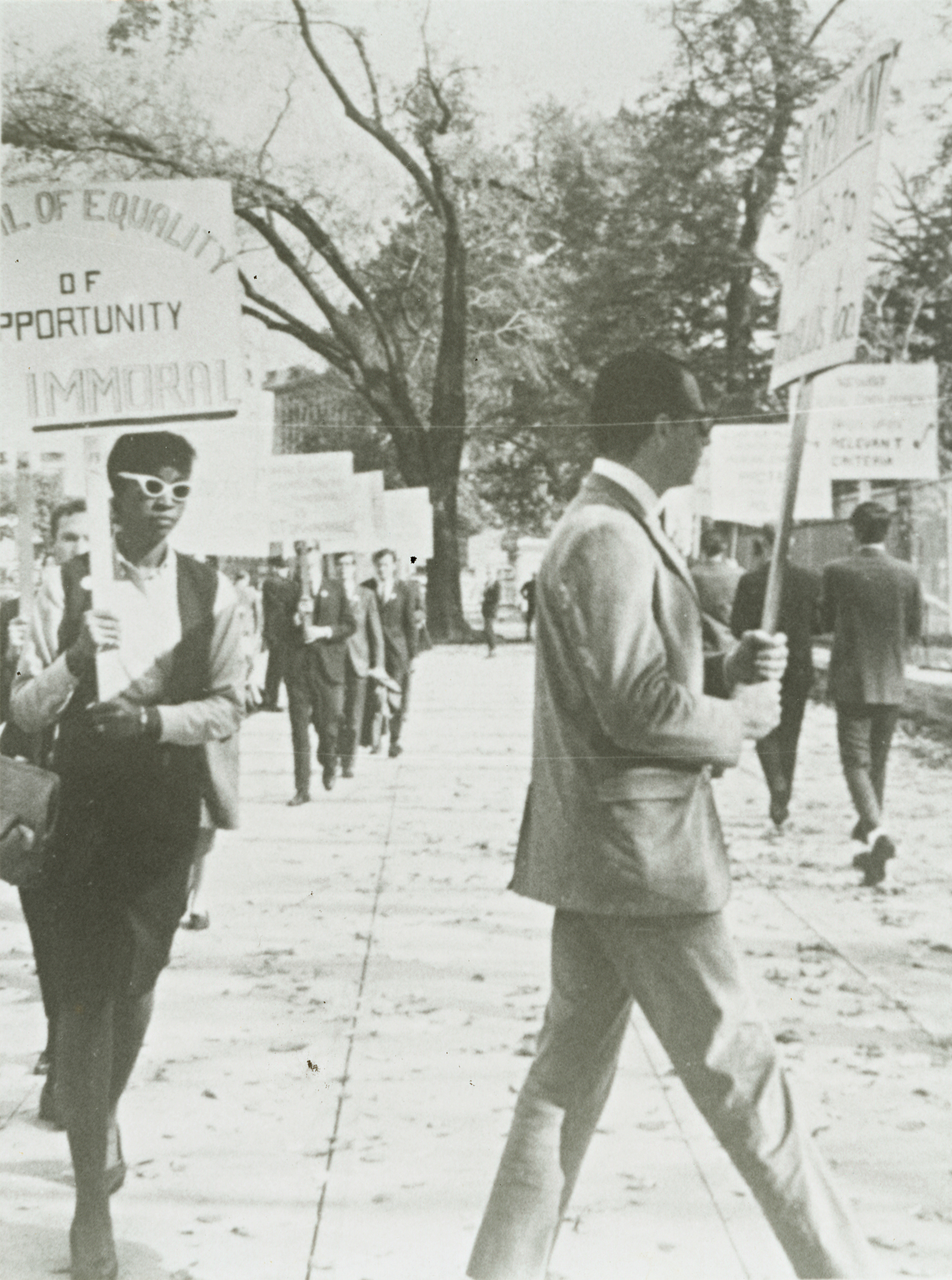
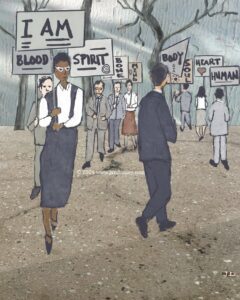
It was MGH’s executive producer Sara Burningham’s idea to renew the search, and she learned from Marcia Gallo’s exhaustive work documenting the Daughters of Bilitis that homophile power couple Barbara Gittings and Kay Lahusen had interviewed Ernestine at great length on tape in 1965. And Sara found buried in Barbara’s papers at the New York Public Library a digitized copy of that very interview.
That’s how we’re able to introduce you to Ernestine Eckstein beyond just her photographs. And it turns out that what she had to say about the early gay rights movement and where she thought it needed to go was every bit as cutting edge in 1965 as her out front participation on some of the earliest gay picket lines and her decision to accept Barbara and Kay’s invitation to be the first African American featured on the cover of The Ladder.
If you listen closely, at one point in the interview, Ernestine describes herself as a “social prophet.” I couldn’t agree more.
———
To learn about Ernestine Eckstein’s early life, before she joined the Daughters of Bilitis (DOB), and to see photos from her college years at Indiana University, click here to read Michael Bedwell’s 2019 LGBTQ Nation article.
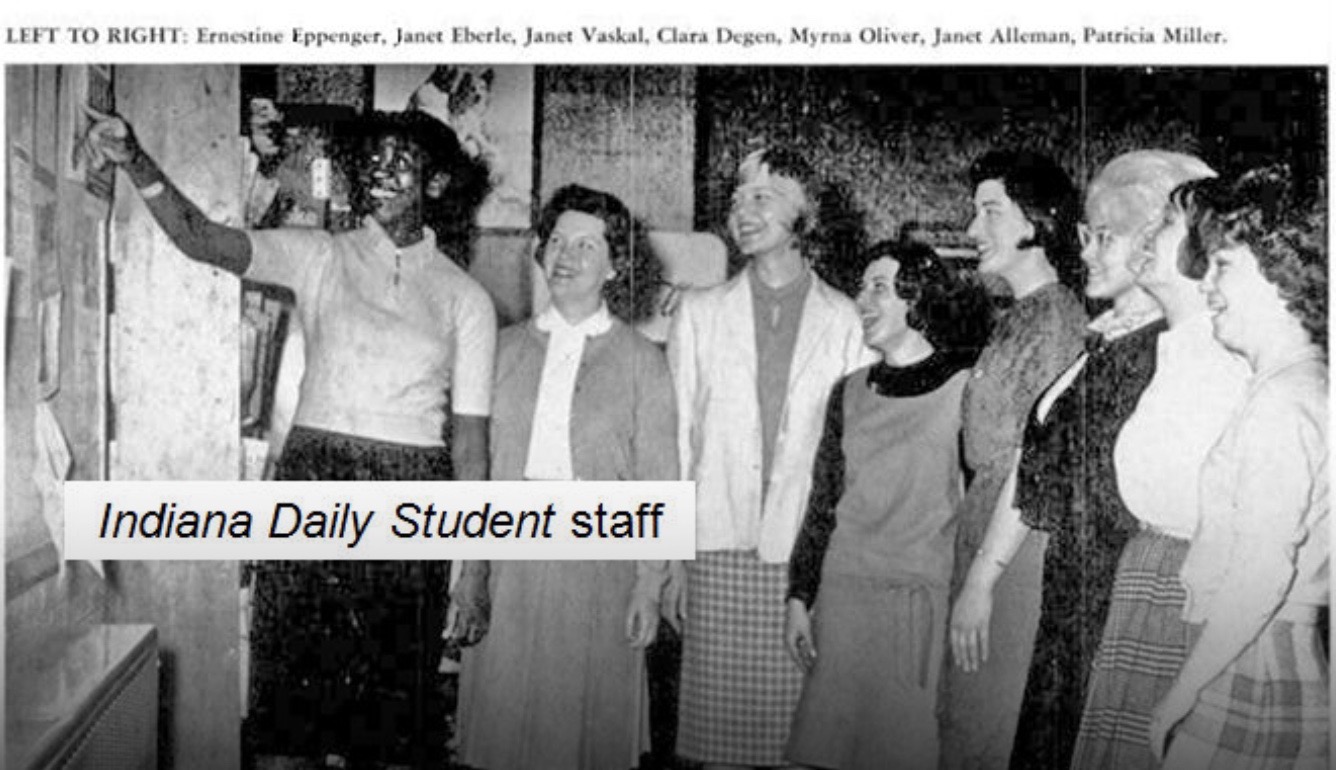
Read an appraisal of Eckstein’s importance as an LGBTQ activist in this article from NewNowNext.
See the June 1966 issue of The Ladder with Eckstein on the cover here and read the interview that Barbara Gittings and Kay Lahusen conducted with her. Gittings and Lahusen were featured in two MGH episodes here and here.
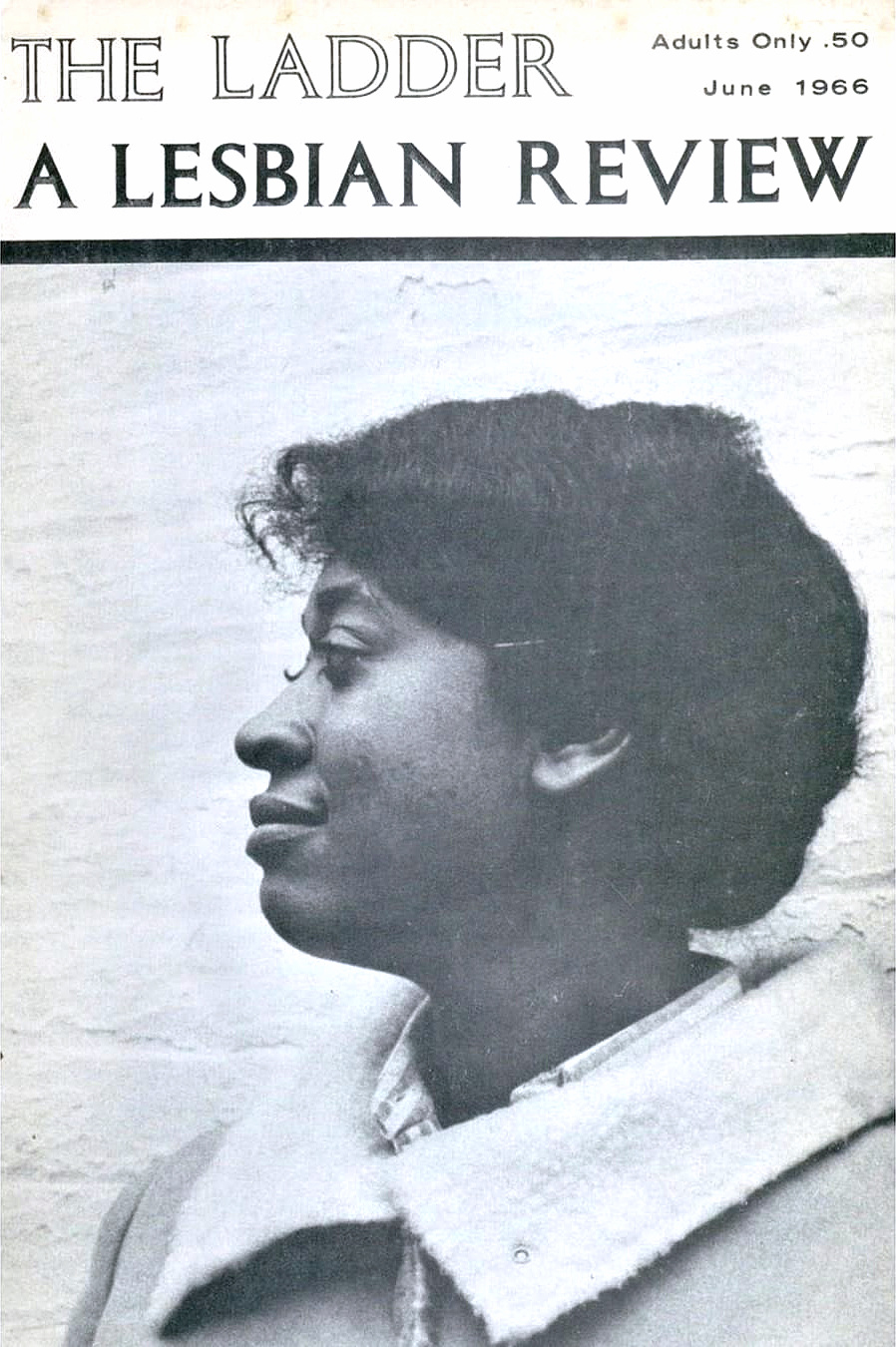
For information about The Ladder, the magazine published by DOB, read this article by Malinda Lo as well as Marcia Gallo’s account of its history here. Also, take a tour of a GLBT Historical Society exhibit about The Ladder in this video.
Eckstein was the first Black lesbian to be featured on the cover of The Ladder. The first lesbian of any race to appear openly on a Ladder cover (in the November 1964 issue) was a Jakarta-based lesbian by the name of Ger van Braam. Learn more about Van Braam in this terrific online exhibit from the Queer Indonesia Archive, which explores Van Braam’s life through her correspondence with Barbara Gittings, the magazine’s then editor.
To learn more about DOB, read Marcia Gallo’s Different Daughters—A History of the Daughters of Bilitis and the Rise of the Lesbian Movement and be sure to listen to our episode with DOB cofounders Del Martin and Phyllis Lyon.
Eckstein was one of the first participants in the July 4 Annual Reminders, which were pickets organized by homophile organizations—under the leadership of Frank Kameny—from 1965 to 1969 at Philadelphia’s Independence Hall. You can see a glimpse of Eckstein picketing at 28:50 in The Homosexuals, a controversial CBS program from 1967 hosted by 60 Minutes veteran correspondent Mike Wallace. You can see footage of the 1968 Annual Reminder in The Second Largest Minority, a short documentary by Lilli Vincenz, here.
Following her involvement with the gay rights movement, Eckstein focused her energies on Black feminist issues and became active with BWOPA (Black Women Organized for Political Action). Read about the organization’s mission and history here.
———
Episode Transcript
Eric Marcus Narration: I’m Eric Marcus and this is Making Gay History.
The first time I saw Ernestine Eckstein—30 years ago now—I had no idea who she was. But I’ll never forget the image. I was looking at black and white photographs of an October 1965 picket line in front of the White House organized by Frank Kameny, founder of the Mattachine Society of Washington, DC. It was one of the first times gay people had organized to come together and publicly demand their rights here in the US.
The photos showed a couple of dozen earnest-looking white men in suits walking in circles, holding protest signs. As far as I could tell, there was only one exception—the only woman I could see in the parade of protesting men. A Black woman. Dressed in stylish office-clothes—a white blouse, dark skirt suit, and kitten heels. Her chic, white-framed cat’s-eye sunglasses standing out in the monochrome image. She was carrying a hand-printed sign with bold lettering. The all-caps message reads: “Denial of Equality of Opportunity Is Immoral.”
She was right there at the vanguard, so visible. But who was she? My research back in the late 1980s turned up a name for her: Ernestine Eckstein. But I couldn’t find her. I only found dead ends. Eventually I gave up. But fortunately another LGBTQ scholar and oral historian didn’t…
———
Marcia Gallo: I’m Marcia Gallo, and I’m a historian of lesbian and gay and bi and trans culture and lives. I wrote a book entitled Different Daughters, A History of the Daughters of Bilitis and the Rise of the Lesbian Rights Movement.
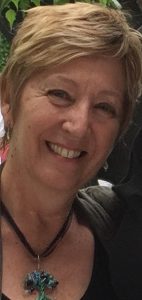
———
EM Narration: In the mid-1960s Ernestine Eckstein was the vice president of the New York chapter of the homophile organization the Daughters of Bilitis, or DOB for short. She was a visionary. She anticipated, predicted, and foreshadowed so many of the issues that would face the LGBTQ community in the decades to come.
Ernestine was also a trailblazing cover girl—in June 1966, she became the first Black woman to be featured on the cover of The Ladder, the magazine published by DOB. Just like me, Marcie Gallo wanted to find Ernestine.
———
MG: I was setting out to challenge the narrative that DOB was this assimilationist, middle class, white ladies group, proper and conventional in all respects. And I was looking for ways to disrupt that narrative.
———
EM Narration: Marcie Gallo didn’t find Ernestine per se, but she found her voice. In this episode, for the first time, you’re going to hear Ernestine Eckstein in her own words.
———
MG: In 2002 when I was working on my dissertation about the Daughters of Bilitis, Barbara and Kay were among the first people that I sat down with of course. And they were showing me all their issues of The Ladder.
———
EM Narration: Pioneering activist Barbara Gittings was the editor of The Ladder from 1963 to 1966, and her partner in life and activism, Kay Lahusen, was a photojournalist who also wrote for the magazine.
———
MG: And I noticed the Black woman on the cover of that famous issue and asked Kay who she was, and she said, “Oh, yes, you must know about Ernestine Eckstein.”
———
EM Narration: Most of what we know about Ernestine and her role in the pre-Stonewall gay rights movement comes from that June 1966 cover story.
———
MG: That she had been vice president of the New York DOB chapter, that she was ahead of her time, that she was pushing people to do more social action work.
———
EM Narration: But Kay wanted to let Marcie know that there was more. Much more…
———
MG: And she told me about the five- or six-hour interview that they had done.
———
EM Narration: All the way back in 1965, when Kay and Barbara interviewed Ernestine for The Ladder article, they taped it. The whole thing.
———
Barbara Gittings: You sit over there so your questions can be heard clearly.
Kay Lahusen: [Inaudible.]
———
EM Narration: Listening to this interview for the first time was like opening a door and walking into the room to meet 33-year-old Barbara Gittings, who’s clearly suffering from a cold, 35-year-old Kay Lahusen, and rising star of the movement, 24-year-old Ernestine Eckstein, who had moved to New York City from Indiana just two years before.
———
KL: Do you want to say what you studied in college?
Ernestine Eckstein: I was in journalism. Magazine journalism. In the School of Journalism at Indiana University, your minor, your first minor is as… There are as many credits involved as a major, so in a sense I had two majors. And then my two minors were psychology and Russian.
KL: And Russian?
[Unidentified Speaker]: I was just gonna say, Russian.
BG: Wow.
KL: Did you learn very much? How many courses did you take?
EE: Certainly!
KL: How many courses did you take?
EE: In what? In what?
KL: In Russian.
[Unidentified Speaker]: What’s Russian, Ernestine? I’m curious.
EE: [Russian phrase.]
[Laughter.]
BG: Sounds a little too familiar.
———
MG: She doesn’t really say much about her background. All we know is her college years. We know that she was a very good student, and that she studied—this was also fascinating—magazine journalism, Russian, and government. Okay. Which reminded me of Lorraine Hansberry, who also studied Russian and was also a journalist, of course. They’ve always reminded me of one another and, as you know, Hansberry had written to the, to The Ladder early on, right before Raisin in the Sun is debuting on Broadway, and says, “I support what you’re doing, but I just can’t get involved.” So Ernestine feels like that kind of intersectional person who is using all of her gifts, all of her experiences, in her, in her political work.
———
KL: And then you moved to New York how long ago?
EE: I moved to New York in May of ’63, almost three years ago. I sort of went through that soul-searching bit of deciding if I were, where I stood, and then once having decided that, the next, on the agenda was to find a way of being in the movement, kind of. Because I always assumed there was a movement or there should be. And having once decided where you are, you then decide what you can do with that.
KL: Really? You mean you decided you were a lesbian and then you decided, well, there must be a movement?
EE: That is about the way it was. Yeah.
———
MG: She just moved to New York because New York seemed like the place to be, she said. Um, knew nothing about gayness in herself or in the world, and sort of starts to explore that when she comes to New York.
EM: People lived in such isolation then about their sexual orientation because there was so, there was so little information.
———
KL: Well, there’s so many homosexuals that we talk with, particularly out in the Midwest or some isolated part of the country, who never dreamed that there’d be an organization.
EE: Really? Well, you know, I have a lot of faith in New York.
KL: Oh, good! So do I.
BG: Is that why you came here? Had you known before that you were a lesbian and you came here?
EE: No. No, I hadn’t known before that I was a lesbian. It’s a very funny kind of thing because I always had a really strong reaction to women. This was a blank that had never been filled in by anything, reading, experience, nothing, through age 22. Graduated, you know, from college and never known anything about this.
BG: And you didn’t know there were other people who felt the way you did?
EE: No, I didn’t. I really didn’t.
BG: When you think about your uniqueness, how did it, how did it affect you?
EE: Well, I used to think, Now what’s wrong with me? You know? But I thought maybe… You see, I’ve always been under the impression, I think, that there was nothing unusual about people reacting to other people regardless of sex. I’ve never thought of it in terms of homosexuality, but I’ve always felt that love, you know, sort of transcends any kind of label like, you know, Black, white, men, women, this sort of thing.
BG: Well then you came to New York and you did…
KL: Were all these faggots running around a big shock to you?
EE: No, no. As a matter of fact, I had a friend in college who had come to New York earlier. He was my best friend. I never knew why. It was never a sexual relationship. Never even a romantic one. He was a homosexual, and I didn’t know it until I came here.
KL: Did he know it?
EE: Oh, he knew it.
KL: But he didn’t tell you.
EE: And he didn’t tell me, you know. So we had a very good relationship going, you know. We could do everything together, you know, really communicate and just the best of friends but never any romance. And I liked it this way, you know. So did he, and I never understood why. But I never thought, I never questioned why either.
And I came to New York and he was one of the first persons I looked up, and he says, “Ernestine, you know I’m gay?” And I thought, Oh, you’re happy, so what? You know. I didn’t even know the term “gay.” And he explained it to me and all of a sudden, you know, all of a sudden things began to click.
And at this time, I was sort of emotionally involved with my roommate anyway. I thought, Am I sexually, you know…? It dawned on me that maybe I was sexually attracted to the girl and not just emotionally attracted. So it was like this. It’s very funny. It really is.
KL: He told you they were all around and you could hardly believe it?
EE: Yeah. He sort of introduced me to the homosexual community. Cuz he’s a real queen. I mean here. He was a little bit different here in New York than he was in Indiana.
KL: I’ll bet.
EE: He was. You know, he’s a nice-looking guy. He sort of swishes around, you know, and looks at all the boys on the street. A real… Way out.
———
EM: What was it like for you hearing Ernestine’s voice for the first time?
MG: It was very exciting. What I thought about the first time I heard the interview was her insistence on social action, that it was time for the homophile folks to get themselves out into the streets.
———
KL: Are you thought of as a radical among lesbians?
EE: Well. That’s really a very hard question to answer. I personally consider myself, um, very average and normal in every sense the word. Not radical, but just simply… This to me is the way to be. Now, I think, compared to other lesbians, my ideas are farther to the left than theirs are. Most lesbians that I know endorse picketing but would not themselves picket. So as far as ideas are concerned, maybe we’re on the same line, but I sort of go a little bit beyond it in that I will get on the picket line, in a different city.
———
MG: Right. And like those great photos of her, the only woman and the only Black person on the picket line with, wearing those white sunglasses. And perhaps she didn’t know how iconic that photo would become—I’m sure she didn’t—but it has, and she just jumps off the page at you because she’s gorgeous and she’s a Black woman wearing a sign about “denial of equality is immoral.” I mean, she’s amazing.
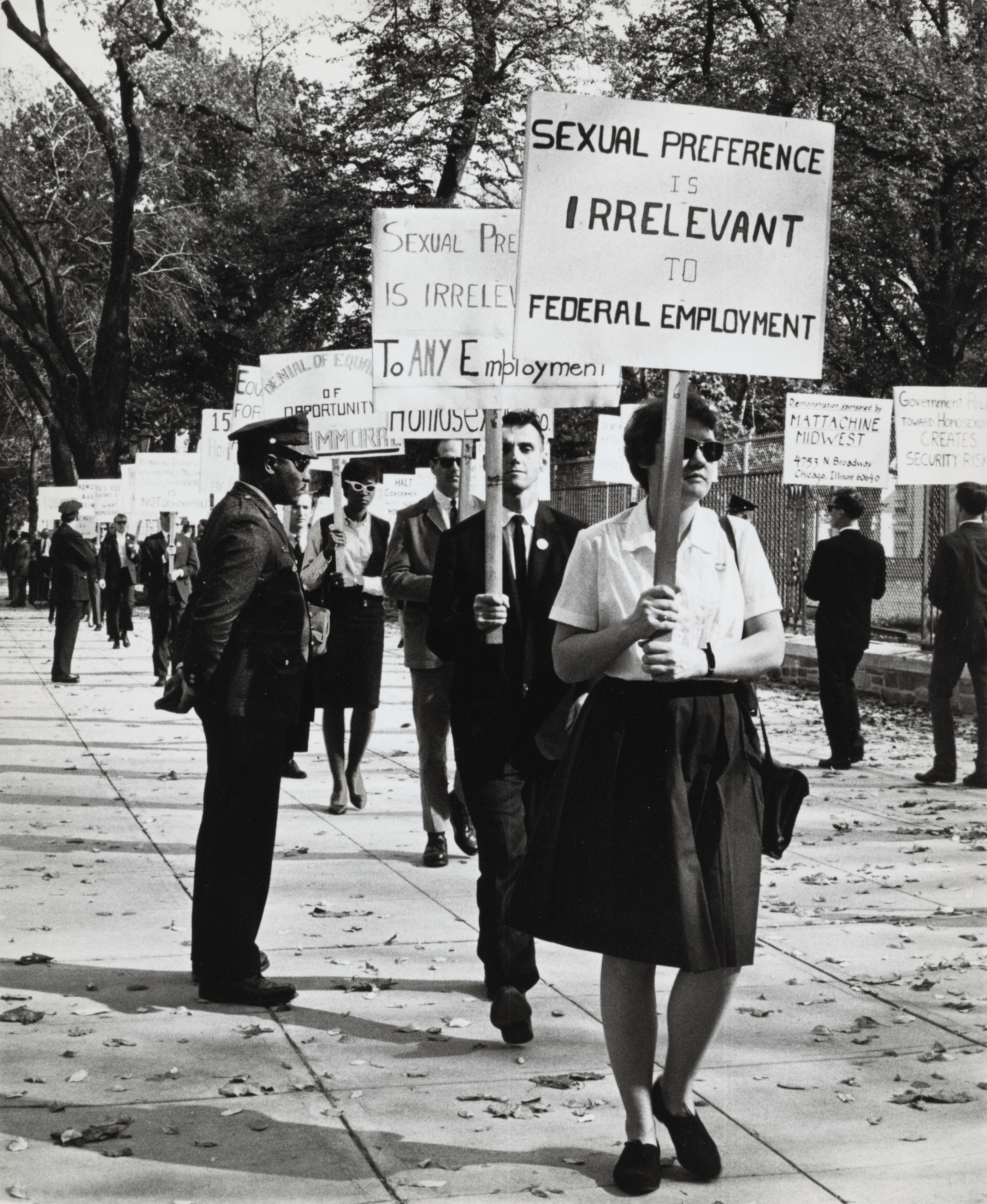
EM: There’s a photo of her in the 1965 protest in front of the White House, and I went, Who is this? And, and now I know. Why is Ernestine such an important figure in the pre-Stonewall movement?
MG: She’s pivotal. She is that person who is, who encapsulates the discussions, debates that are happening about visibility. And about even calling it a movement as opposed to organizations who were helping people to adjust to their status in the world, which was sort of the homophile attitude, I think. You know, we’re here for one another to make our way in this hostile environment. And she comes along and start saying, “Look, we’ve got to learn from what Black folks did, we have to look at the civil rights movement and we’ve got to get out there, make our demands, know what we’re all about, and be very visible and public about it.”
———
KL: Do you believe in forms of civil disobedience for our movement at this time or in the future?
EE: Picketing, I regard it as very, almost a conservative activity now. Sit-ins, you know, and that kind of thing are the thing. And all of this is the educational process of calling attention to the unjustness of the situation, which is the same thing the Negro did.
KL: Then we’re back again to the professional persons who say, “Don’t picket,” which is a form of political action, but educate in these sort of namby-pamby ways, I suppose you would say.
EE: Yeah, that to me is a difference in definition of education.
BG: You define the picketing as a form of education.
KL: I define it that way, too.
EE: Definitely, there is no question about that.
———
MG: The other thing that’s interesting is that I heard Ernestine use the phrase “come out,” which wasn’t in the lexicon at that moment, you know. Barbara talked about “revealing ourselves.” Folks talked about “becoming more visible,” “taking off the mask,” those kinds of things. She used the term “come out,” and I thought maybe it’s starting to become the way we talked about it.
———
EE: Well, one thing I would like to see is a kind of respect for self-development among all homosexuals so that they can, they can date in public, for instance, you know, openly. So they can react as other people do to situations publicly, you know. Not become professional homosexuals, but feel a kind of freedom within thems–. I think it’s a personal thing. I don’t think this is part of the movement. I think this is a personal thing.
BG: But do you think it’s possible in the present climate of opinion for homosexuals who have self-confidence in themselves to do this openly?
EE: I think it takes a lot of courage, and I think a lot of people who do it will suffer because of it. But I think any movement needs a certain number of courageous martyrs. There’s no getting around it. That’s really the only thing that can be done, you have to come out and be strong enough to accept whatever consequences come. I think.
BG: So really you’re suggesting that more and more homosexuals declare themselves and act in the ways that they want to, that they would act if the restrictions were removed and the prejudice were removed.
EE: Exactly, I do.
BG: And you think this will help to abate the prejudice in itself?
EE: I do.
———
MG: She is so thoughtful and provocative, especially the give-and-take with Barbara and Kay, who are very strong personalities, as you know, and so is she. What I think I love the most listening again recently are the pauses when she would stop, not let herself be pushed into a response that she wasn’t ready for, and she would take the time either to agree or disagree, often to disagree, very gracefully, with something that they were arguing about. They wanted her to make very clear, to draw very clear connections between the Black civil rights movement and the gay movement, and she was much more thoughtful. I mean, she certainly saw the connections but she also kept saying, the gay movement is not where the Black civil rights movement is, the gay movement isn’t even close, you know, we’re still about accepting ourselves, you know. So I… Hearing her brought this enigma to life.
EM: And there she was on tape. Not only on tape, but talking to Barbara Gittings and Kay Lahusen. Twenty years before, more than 20 years before I interviewed Barbara and Kay. Sounding… they themselves sounding much more tentative than when I knew them later.
MG: Interesting.
EM: And interviewing Ernestine in a way that suggested they were almost treating her like a specimen.
———
BG: What do you think of this this attitude on the part of homosexuals who are impatient to have their rights now and not simply wait for the slow process of change?
KL: You know, Dr. Pomeroy, for example, falls back on education. Now we’ve got to wait and educate.
BG: The homosexuals who feel strongly about this point of view fault him for that point of view by saying, “Well, he’s a heterosexual and isn’t suffering under the system the way we are.” We’re just trying this out to see how you react to it. As one who is in another minority situation.
EE: Well, speaking for a moment of the other minority, the Negro minority. I feel, I find it very difficult to wait as a Negro. I think, though, in the homophile movement, you have a different kind of situation. I don’t think you have any choice but to wait. That is, I think we cannot be as radical as homosexuals as we can, as we could, and as we do, as Negroes. Because the Negro cause is already widely accepted, you know. You know, the right of a man to vote and to work and to go to school regardless of color. The homosexual cause is not yet accepted, and I think this has to come first. The acceptance. Then you can push as far and as often and as hard as you like.
The homophile movement and the Negro cause, movement are different. I think we have at this, that is we the homophiles have at this point to be, to a certain extent, inner-directed. I think this will change as we become more accepted, but everything is based on acceptance at this point or at least toleration or at least to get an audience, and we can’t even do that yet.
KL: Are there any ways in which you think our own movement could emulate the Negro or other movements that it’s not doing right now?
EE: I don’t find in the homophile movement enough stress on courtroom action. That is, I can’t envision at this point President Johnson coming out in favor of a bill for homosexual rights to work in government today. I can’t even envision there being any kind of bill comparable to the 1954 education bill. I would like to see more test cases in court so the thing can be brought out in the open. I think the more we have of this, I think we have very little of it now as far as I know.
———
EM: So that’s another thing Ernestine was focused on. More court cases. Was that groundbreaking?
MG: Yes. And there’s a gay bar in Atlantic City that Ernestine talks about New York DOB helping raise funds for their legal defense. It was really an issue around, “Can gay people even go into a bar and socialize?” There had been no misconduct alleged, just “You’re a bar, gay people come here, we’re shutting you down.” So things were starting, but it was still very groundbreaking to start to sort of urge those kinds of actions. Yeah, and she was right there.
EM: She uses the term “transvestite,” which was acceptable at that time—it’s not now—but she’s asking for the movement to be—what movement there was—to be a coalition that includes people we think of as trans people today, which I thought… 1965…
MG: Amazing. Absolutely. Yes. That’s, that’s also quite stunning.
———
EE: There are certain broad, general problems that we all have as homosexuals, you know, across the board, so to speak. And we should concentrate on those: the draft, civil service employment, the church rejection of us, this kind of thing that touches us all. Maybe even the question of transvestites, I think this has been neglected. Anything that can affect us all.
KL: I’m surprised you threw that in, the transvestites. You mean that we should think about their right to dress as they please without discrimination or…?
EE: You see, I feel that the homophile movement is only part of a much larger movement of the erasure of labels. And I think the right of a person to dress as he chooses must necessarily follow when we expand our own philosophy of bringing about change for the homosexual.
KL: They have two organizations of their own and they’re really a vast vast number of people just don’t realize how many heterosexual men would like to let go and be feminine in this way.
EE: Yeah, well I’m not saying it’s exclusively a homosexual problem, but I am saying it’s a problem of sexual identity. You know. And so far as society’s concerned, the two are lumped together. And therefore, once we solve ours, I see no reason why we cannot begin to expand into other areas. And this one is so closely allied to our own.
BG: You think you’ll still be around when that time comes?
EE: Uh no, I don’t think it’ll be in my lifetime, no, no. Just projecting.
[Laughter.]
EE: I’m being a social prophet but it’s the goal I think to work for.
———
MG: At a moment when people are moving much more towards sort of segmentation and labeling, she’s saying, “Hmm, I think ultimately we’re going to have to be a broad enough tent.” So she’s sort of foresaging the LGBTQ etc. kind of momentum of the movement.
EM: In a way Ernestine is kind of educating Barbara and Kay on intersectionality.
MG: Oh, yeah.
EM: Before the word was in use. Is that your impression?
MG: Absolutely. Oh, it’s exactly what she was doing. She was, she was saying, as Audre Lorde would say a few years later, “When I walk into the room, do you see a Black person, a woman, a lesbian, a mother? You see all of that. That’s all of who I am.” And Ernestine is is stating those kinds of realities, and your comment that they were treating her somewhat as a specimen I think is really right. I don’t know how—and maybe that’s why it was a five- or six-hour interview—I don’t know how often, if ever, they had the opportunity to sit down and be honestly quizzing a Black lesbian about her ideas, her life, her thoughts, her her vision for the movement. And they really took advantage, I mean, and she was willing to do it, but I think that she embodied something brand new.
———
EE: I regard homosexuality or homosexual love personally as a higher form of love than heterosexual love. No, seriously, very seriously, I think, speaking again personally and I guess mainly as a lesbian, it is much more beneficial to me and much more… I communicate much more easily, sexually and every other way, with a woman than I do with a man. Therefore, to me, a woman that I am dating and I reach a closer kind of unity than a man and I ever could. And for this reason, to me is the higher form of love.
BG: But you’re saying this is for your own experience, not that you think homosexual love in itself as an entity is better than heterosexual love.
EE: I’m saying potentially it is. I’ll say it does not so far as I know, it does not generally reach this level, from what I’ve seen. So far as I’m concerned, homosexuals limit themselves too much to sex. I think this is created out of need, though. Sex is not as available to homosexuals as it is to heterosexuals, you know.
BG: So more time and energy are expended on this thing.
EE: Exactly, exactly. That’s the problem.
BG: And this is why you think that social activities sponsored by the groups are a good thing because they will provide the need that you need?
EE: Exactly.
BG: But what about charges from the heterosexuals that this makes a procuring agency for illegal sex. What about this?
EE: I think we have to decide how far we can go for caring about what heterosexuals think. You know. We want acceptance and we want our rights as citizens and as people, but this doesn’t mean that all of our activity and all of our goals are defined by other people’s filthy minds.
The homosexual is hidden, except for the stereotypes, you know, and I think they have to become visible, you know. And assert themselves politically in every way that any other group does, you know. And I think once they begin to do this, society will begin to give more and more and more.
KL: You think of this as what’s involved in going out to meet society.
EE: Oh, of course.
KL: You don’t think of it in terms of putting on a skirt and getting out of the bar.
EE: No, no, I don’t think of it in terms of that. I still think people ought to be free to do, to assert themselves as they choose. And if people want to go to bars, that’s their business. If they want to wear pants, that’s their business also.
KL: You don’t think in terms of being more responsible, a better citizen.
EE: I personally don’t know exactly what the definition of a responsible citizen is other than that you vote and that you write to your congressman, you know, and that you hold down a responsible job, that you are somehow a productive human being. Aside from that very broad definition, I don’t know what responsibility means, you know. I know it doesn’t mean that you conform in your clothing or in your religious practices, this sort of thing. Or in your sexual preference.
BG: Well put.
———
EM: So Ernestine Eckstein is on the cover of The Ladder and gives this visionary interview to Barbara and Kay. And then she essentially vanishes. What happened?
MG: What we know are nothing conclusive but there’s little hints. For example, Frank Kameny.
———
EM Narration: And a quick reminder that Frank Kameny was the founder of the Mattachine Society of Washington, DC, and a proud militant homosexual who coined the phrase “gay is good.” He was the organizer of the 1965 protests that Ernestine marched in.
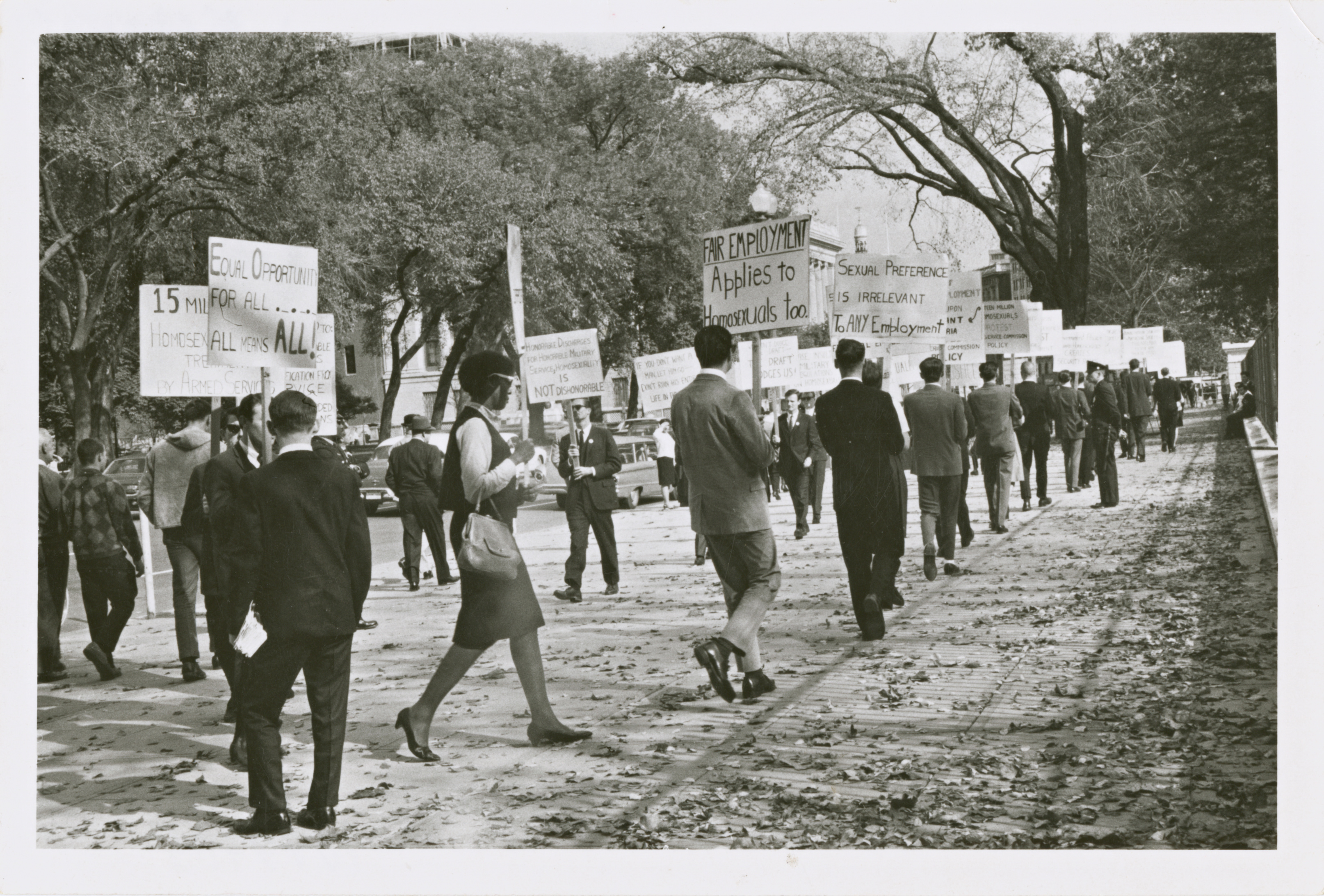
———
MG: She had invited him to speak to the New York chapter and was overruled by the chapter and had to disinvite him. So between the time that she gives the interview to Kay and Barbara and it appeared in The Ladder, which was ’66, June ’66, she’s no longer vice president.
So my guess is that she couldn’t manage the conservatism of the chapter. She sticks around for a little longer but not as a leader, and then goes to the Bay Area, and all we know is what other people have said she said, which is that she was sick and tired of the infighting.
So it seems like there was a severe break for her, and I guess an awareness that there was a group she could put her considerable energies into, which was Black Women Organized for Action, which is in itself an amazing organization in the Bay Area, led by phenomenal Black women activists. And maybe her own maturation as an activist was leading her much more into that Black feminism. That’s what it seems like.
EM: Ernestine Eckstein is a pseudonym.
MG: Yes.
EM: How do you feel about revealing her given name?
MG: I think I still come down on the fairly conservative side of treating it as the name she used in the movement. Eckstein is the name she used, therefore that’s what I used. And as I continue to write about her, I will continue to use it.
EM: So even though her name is out there publicly, you prefer not to use it.
MG: I do, I do. I’m imagining what her wishes might be, even though we’ve never met, we’ve never talked.
EM: What do we know about Ernestine for the last few years of her life, and when did she die?
MG: Died in ’92. I know that she died in San Pablo, California, which is in the East Bay, and I don’t know what she died from. Although I had heard from a woman who knew her in the Black Women Organized for Action group, who’s also now passed away, that she hadn’t been well. So I don’t… That’s about as much as I know. I don’t know if she… I like to think she had friends and a partner and a good life there.
EM: So if there’s anyone out there listening who knew Ernestine Eckstein, please write to me, Eric Marcus, eric@makinggayhistory.org, and let us know. We’d love to know more about this incredibly important, pivotal person in the movement, who thought of it as a movement before most people did. And we don’t know that much, but we know, thanks to you, we know a lot more than we did before.
MG: Well, thanks to those who did interviews and kept records of them. Yeah.
EM: Thanks so much for joining us.
MG: Thank you, Eric. This is been wonderful.
———
EM Narration: Huge thanks to everyone who makes Making Gay History possible: executive producer Sara Burningham, audio engineer Pran Bandi, producer Josh Gwynn, production coordinator Inge De Taeye, photo editor Michael Green, and social media producer Denio Lourenco. Special thanks to Jenna Weiss-Berman. Our theme music was composed by Fritz Myers.
Making Gay History is a co-production of Pineapple Street Media, with assistance from the New York Public Library’s Manuscripts and Archives Division, which provided us with the Ernestine Eckstein archival tape, and the ONE Archives at the USC Libraries. Season four of this podcast has been made possible with funding from the Jonathan Logan Family Foundation, the Ford Foundation, the Calamus Foundation, and our listeners—like Carole and Dick Rifkind.
Carole and Dick have been supporters of Making Gay History since before there was a podcast, and personal supporters and dear friends for nearly 40 years. Dick died on New Year’s Day. He was 88. Our hearts go out to Carole and her family.
Dick was a man of few words, so I listened when he offered advice. About Making Gay History he said, “Think big.” And we have. You can have a look at makinggayhistory.org to see how Dick’s advice has inspired us to share these stories beyond the podcast.
So long! Until next time!
———
Are you still there? Here’s a little something extra. I told you at the top of the show that Ernestine Eckstein was a trailblazing cover girl. Well, she was also a slightly reluctant one. Having your face plastered on the front cover of a magazine for lesbians carried big risks in the 1960s. But Barbara and Kay wanted to find a way to make it work.
———
BG: Well, listen, Ernestine, I have a feeling there might be a way of taking a picture of you for the cover that would not imply that your features are being concealed, but that nonetheless would have this effect. Kay has an example, look.
EE: Any way you can do it.
KL: There are several ways. You can blur somebody going along on a motor scooter or… if you have a motor scooter.
EE: As long, as long as my supervisor in the office could not look at this and say, “Now, Ernestine, I recognize your eyes in that,” you know. Really, I’m willing to try anything.
KL: We never show a picture unless someone signs a release.
BG: Well, obviously she’s willing to…
KL: Picture of a girl like this that’s a half face that we’re going to be using sometime soon.
BG: The only thing I objected to that after I had it was that it may imply half a woman.
KL: Yeah.
EE: Oh, yeah.
KL: Suppose we shot you in a car mirror, you see? At that much of a distance, you can’t really tell too much. Well, you don’t, you don’t ride a motor scooter do you? A girl on a motor…
———
EM Narration: Have a look at the episode notes at makinggayhistory.com to see a contact sheet from that shoot. Apparently the motor scooter idea didn’t pan out.
So long! Until next time! No, I mean it this time.
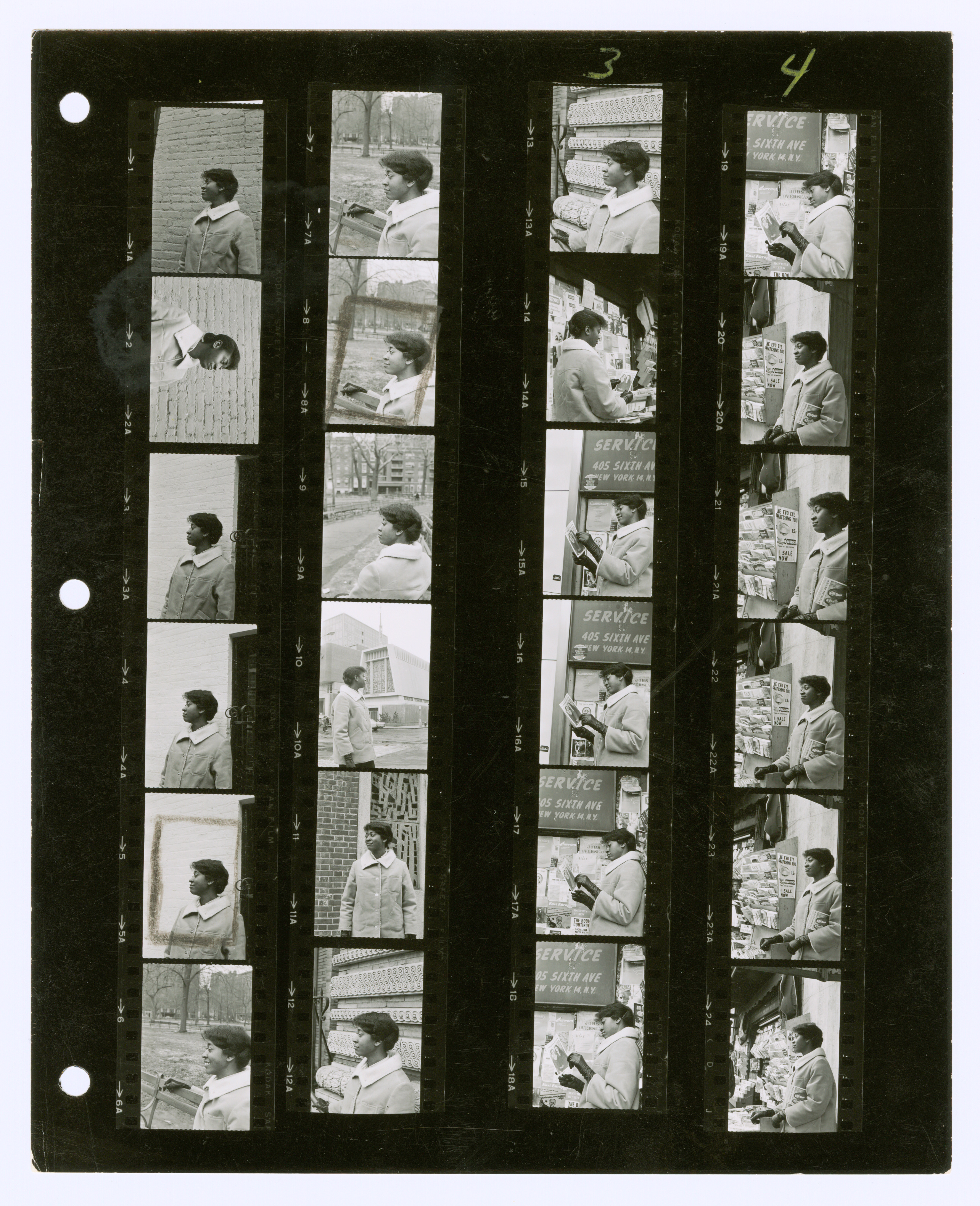
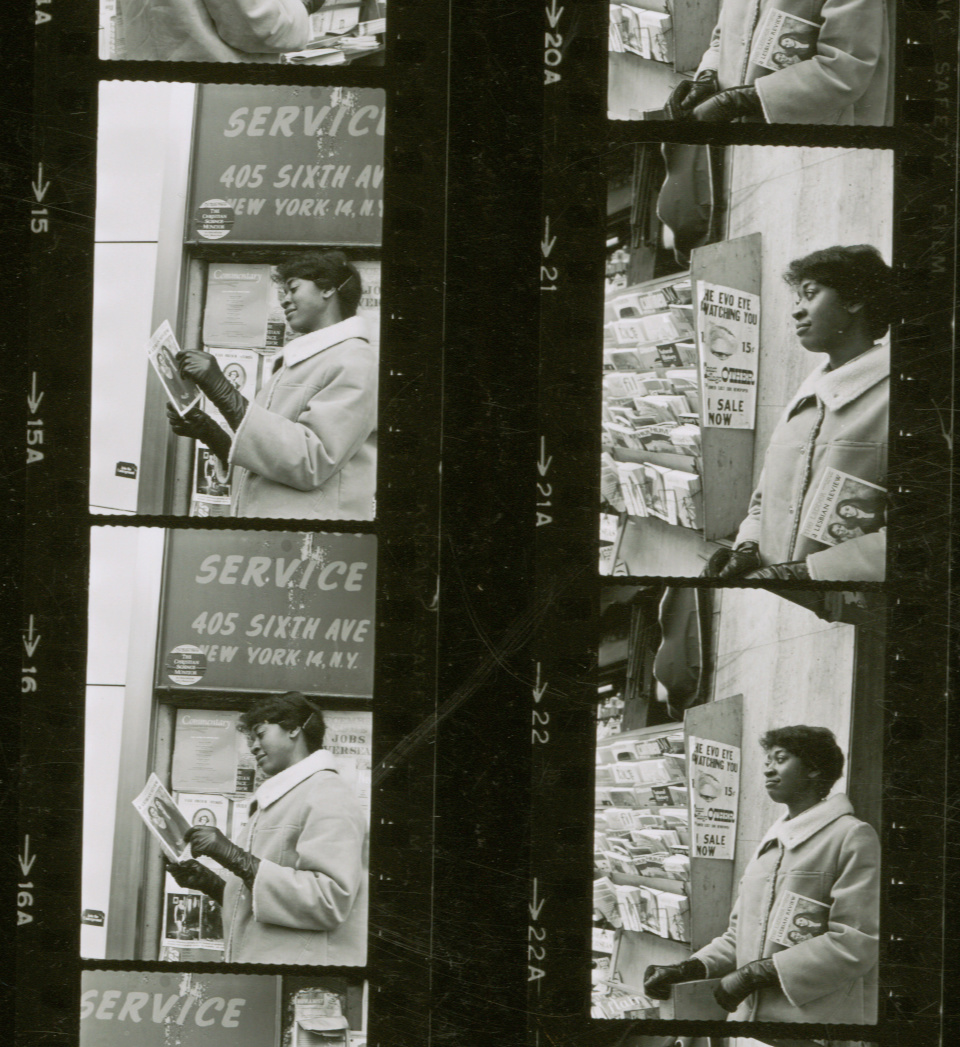
###